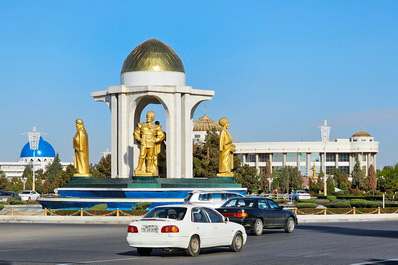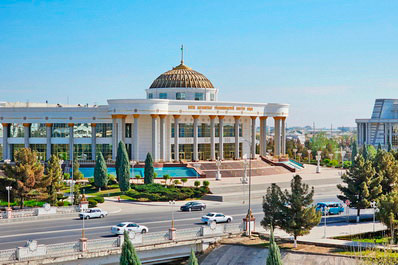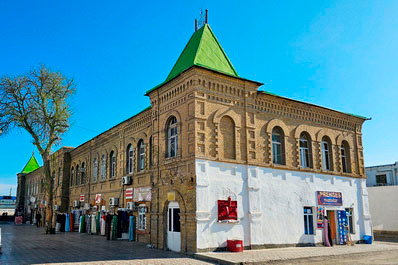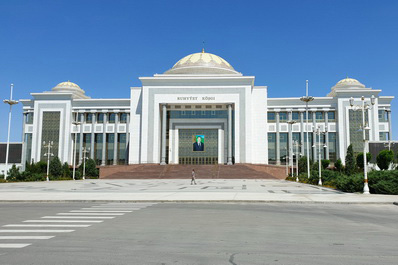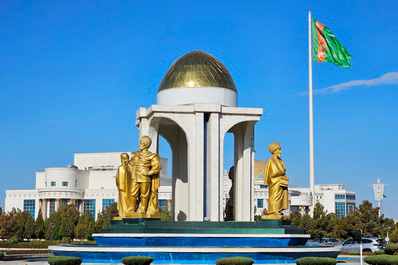Mary, Turkmenistan

Former names: Merv (New Merv)
State language: Turkmen
Time zone: UTC+5
Population: 208 697 (2024)
Telephone code: +993 522
Postal code: 745400
Vehicle code: MR
Located in southern Turkmenistan, Mary is a modern city founded in the late 19th century. It serves as the main hub of the republic's gas industry. For tourists, Mary offers a glimpse of the true essence of Turkmenistan, with its tall buildings, wide streets and historic monuments. However, the city's main attraction lies 30 kilometres to the east - the ancient ruins of Merv, an archaeological and historical treasure.
Below is essential information to help you plan your trip to Mary.
How to Get to Mary
Mary has an airport with domestic flights to cities such as Ashgabat, Dashoguz, Turkmenabat and Turkmenbashi. To get to Mary, fly to Ashgabat and take a domestic flight from there. Alternatively, you can drive to Mary from Ashgabat or Turkmenbashi.
Mary Tours
Mary is often included as part of tours to ancient Merv. After exploring the ruins of ancient fortresses and mausoleums, visitors head to Mary to explore the History Museum, which houses artefacts from the excavations of Merv. There are also opportunities to visit key landmarks in the city centre, including:
- Gurbanguly Hajji Mosque
- Pokrovskaya Orthodox Church
- Turkmen Carpet Museum
Tours can also include cultural attractions such as monuments to poets and prominent figures, the city's Drama Theatre, Palace of Culture and libraries. For those interested in Turkmenistan's equestrian heritage, a visit to the Akhal-Teke Horse Breeding Farm is a unique experience.
Brief History of Mary
In 1884, the Merv oasis became part of the Russian Empire, necessitating the establishment of a military administrative centre, initially named Merv. In 1937 the town was renamed Mary.
In 1954, the construction of the Karakum Canal began, starting at the Amu Darya River. By 1959, the canal had reached Mary, bypassing the city to the south, and was later extended to Ashgabat, with construction completed at Geok Tepe in 1967.
Following Turkmenistan's independence, Mary became the capital of Mary Province on 18 May 1992. The early 2000s saw significant urban development, with the construction of residential buildings, educational institutions, theatres, museums, libraries, stadiums and medical centres.
Today, Mary is known for its carpet weaving, horse breeding, medicine, transport infrastructure, sports and cultural activities.
In 2012, Mary was named the Cultural Capital of the CIS, and in 2015 it was recognised as the Cultural Capital of the Turkic World.
Mary Sights & Attractions
Evening walks around Mary offer visitors the chance to admire two of the city's most remarkable attractions.
- Intercession Orthodox Church: Built in 1900, this well-preserved church is a symbol of the city's rich architectural heritage.
- Gurbanguly Hajji Mosque: Built in 2009 and named after the President of Turkmenistan, Gurbanguly Berdimuhamedov, this grand mosque boasts a majestic design and four soaring minarets, each 63 metres high.
For horse enthusiasts, a visit to the Akhal Teke Horse Breeding Farm is a must. Here, visitors can witness the elegance, speed and beauty of the world-famous Akhalteke racehorses.
After exploring the city, tourists often head to the ancient ruins of Merv, including the fortresses of Gyaur Kala, Erk Kala, Sultan Kala, Abdullahan Kala and Bayramalikhan Kala, along with the Sultan Sanjar Mausoleum and other historical sites.
Mary Museums
Mary is home to two fascinating museums:
- Carpet Museum: Turkmenistan is renowned for its ancient tradition of carpet weaving. Visitors can admire the intricate designs, vibrant colours and unique patterns passed down through generations, showcasing the mastery of local artisans.
- Mary Museum of History and Local Lore: This three-storey white building of unique design houses six exhibition halls with 40,000 exhibits. The museum's collection ranges from archaeological artefacts unearthed in ancient Merv to objects from the independence period.
Food in Mary
As in the rest of Turkmenistan, meat-based dishes are central to Mary's cuisine. Common meats include lamb, camel, beef and poultry, which are used to create a variety of traditional dishes:
- Turkmen pilaf (ash) with dried fruits.
- Ishlekli: A meat pie traditionally baked in hot sand.
- Kazanlama: An ancient dish that requires complex preparation.
Mary also offers several restaurants and cafes serving halal cuisine, offering a variety of options to suit different tastes.
Transportation in Mary
Buses and taxis are the main modes of transport in Mary for both residents and tourists. The city has 14 regular bus routes. Fares for public transport are 30 tenge (0.3 manat), while taxi fares range from 20 to 30 manat, depending on the distance.
In addition to buses, shuttle buses run throughout the city, providing convenient options for shorter journeys. Mary will also open a new bus station in 2022, further improving the city's public transport network.
Best Time to Visit
Mary, like much of Turkmenistan, has an arid, hot climate influenced by the surrounding desert of the Merv oasis.
- Autumn (September–October) and spring (April–May) are the best seasons to visit, with pleasant temperatures ideal for sightseeing.
- Summer temperatures often exceed 40°C, so summer travel is not recommended. If visiting during this season, it is advisable to go out in the morning or evening and stay indoors during the hottest part of the day.
- In winter, temperatures generally hover just above 0°C, but northern winds can occasionally bring temperatures as low as -20°C. Visitors traveling during winter should bring suitable warm clothing.

